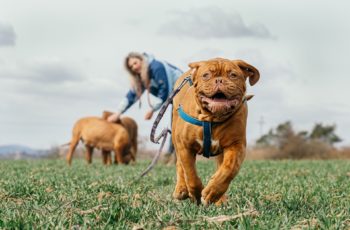Pet health-related emergencies can happen at any time, but when they do, they often catch owners off guard and unprepared. The situation can be particularly scary for a puppy parent, as puppies are typically more fragile, sensitive, and prone to accidents than their adult dog counterparts.
A first-time puppy owner should get acquainted with puppy first aid as soon as possible. Being able to apply first aid properly will contribute not only to your puppy’s well-being but also your own. Here are seven tips that will help any puppy parent administer first aid at home.
1. Make Sure Your Puppy Is Comfortable
Before you start implementing any first aid techniques on your puppy, you’ll want to make sure they feel relaxed and comfortable. Administering first aid when they’re scared can be difficult and even counterproductive, so make it a point to reduce their anxiety and fear about being ill or injured. Create a warm and cozy environment by speaking to them in a soothing voice. Reassure them that everything is going to be okay as you gently stroke them or pat their head. Comfort them with their favorite blankets or other soft items like custom dog bandanas. Smelling familiar scents can help ease their stress about their condition.
2. Assess Your Puppy’s Condition
As a puppy owner, it’s important to know how to assess your puppy’s condition in a quick, but thorough manner. This can make all the difference in your puppy’s chances for successful treatment and recovery. If your pup has been playing outside or with different objects and is suddenly behaving differently, check for any signs of injury or distress like rapid breathing, whining, or limping. Being able to spot changes in your puppy’s behavior, posture, and regular habits can also help determine the urgency of the situation and what steps to take next. This is an important tip to remember and eventually practice in your puppy’s daily care.

3. Learn How to Handle Cuts and Scrapes
Puppies are furballs of pure energy, and there’s no avoiding their tendency for horseplay and running around. But that also means that you can expect the occasional nick or scrape from their antics. Knowing that, it’s always a good idea to have a pet first aid kit close by, filled with first aid essentials like dog-safe antiseptic and gauze. When your puppy comes up to you with a fresh cut, clean the wound gently with the antiseptic. Once it’s thoroughly cleaned, cover it with a gauze pad. If the bleeding continues, consult your vet immediately.
4. Know What to Do If Your Puppy Is Choking
Dogs are prone to choking, and since puppies are curious and like to play with their toys or other non-toy objects, choking is an even bigger safety concern for them. Although this can be avoided by giving them small portions of food or ensuring that their toys are big enough to avoid being swallowed, it is still necessary to know what to do if your pup accidentally chokes on something. Puppies who are choking display signs of extreme distress like pawing at their mouth, retching to try throwing up the object, or gagging and gasping for air. When your puppy exhibits any of these signs, quickly open their mouth and remove whatever is obstructing their airway using your fingers. If you have a pair of tweezers nearby, this can help with getting smaller objects that are lodged in their throat. Always remember to grab the object out and never push it further down.

5. Act Quickly to Address Burns or Scalds
If your puppy accidentally knocks hot soup or coffee on themselves, they may end up in great pain. In more serious situations, they may even burn themselves. To help your tiny pooch with minor burns and scalds, rinse the affected area immediately with cold water for at least five minutes. After that, apply a cold compress. If the burn is more severe, it’s best to contact your vet right away for immediate treatment.
6. Learn to Recognize and Manage Heat Stroke
Your little rascal may be a fan of the great outdoors and love sunny walks in the park, but be careful not to let them get too carried away when they’re directly under the hot sun. Heat stroke is especially dangerous for younger dogs, and the most telltale symptom of is excessive panting. They may also exhibit drooling, extreme discomfort, and lack of coordination in their limbs. When this happens, immediately move your puppy to a cooler environment and offer water in small doses instead of dumping it on them all at once. If symptoms persist, contact your vet as soon as possible.
See also

7. Address Diarrhea or Vomiting Immediately
Whether it’s a change in diet, an upset stomach, stress, or accidentally eating something they shouldn’t have, diarrhea and vomiting can be a common (and unfortunate) experience for young puppies. But it can also be more dangerous than you realize, as frequent diarrhea and vomiting could lead to dehydration and severely weaken your puppy. To help alleviate the symptoms of either diarrhea or vomiting, offer them bland food like rice or boiled chicken for a few meals. If they continue to throw up or have loose bowel movements, it’s important to consult your vet for medication and further evaluation.
Conclusion: It’s Better to Be Pup-pared for Anything
First aid knowledge can certainly empower you as a puppy parent and give you a great sense of relief about their wellbeing, knowing that you can handle and respond to any pup-related emergency that may come your way. Use these tips as a reference for taking care of your puppy and ensuring their day-to-day health and protection from harm.
About the Author: Charmaine Miller is a lifelong pet lover and animal rights advocate. She works as a pet sitter and dog walker by day and volunteers at a local animal shelter by night. In her spare time she loves to bake, write, and sing to her favorite Beyoncé songs.


